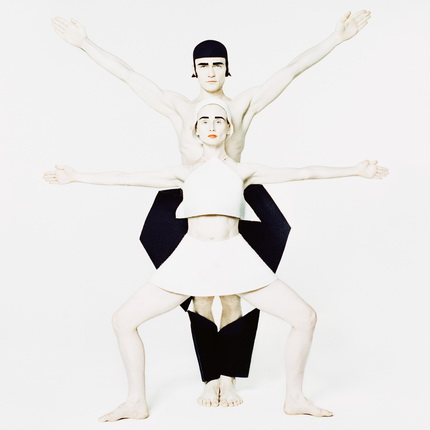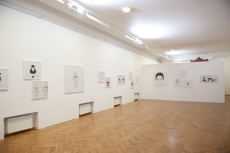Re-Constructivism






Vladimir Glynin. “Re-Constructivism”. 2010. Author’s collection
Vladimir Glynin. “Re-Constructivism”. 2010. Author’s collection
Vladimir Glynin. “Re-Constructivism”. 2010. Author’s collection
Vladimir Glynin. “Re-Constructivism”. 2010. Author’s collection
Vladimir Glynin. “Re-Constructivism”. 2010. Author’s collection
Vladimir Glynin. “Re-Constructivism”. 2010. Author’s collection
Moscow, 23.03.2013—12.05.2013
exhibition is over
Zourab Tsereteli Gallery of Fine-Arts
19, Prechistenka street (
opening hours: 12:00 - 20:00, Friday 12:00 - 22:00, Sunday 12:00 - 19:00, day off - Monday.
Tel: + 7 (495) 637-25-69
Share with friends
For the press
Constructivism is a Soviet Avant-Garde movement in the visual art of the 1920s that involved architecture, photography, clothes. Photographer Vladimir Glynin shot his Reconstructivism (2011) project appealing to a well-known ironic style. «Re» as a prefix, grammar tells us, means either a «repeated, renewable, reproducible act» or «an act opposite in its meaning to the basic part of the word.»
It is meaningless to «oppose» Constructivism. It is our recognized great heritage. We are left with reproduction as a result, we have a Post-Modernist trick here — quite an exquisite one, I must say. Avant-Garde, just as icon-painting, has absolutely turned into «art for export» today. It is tempting to work with such exemplary visual models, but few people are successful in it. Kazimir Malevich was successful, he interpreted the methods of icon-painting in many ways (Glynin claims, by the way, that this Russian Avant-Garde artist is his idol). The Reconstructivism series is also a success.
The main theme here is the subject, the dance. Seagull, a 2002 ballet performance staged by John Neumeier who adapted the Chekhov play for ballet. The Soul of the Seagull is in the «Constructivist» dance in the costumes resembling «prozodezhda» — industrial clothes of L. Popova, A. Rodchenko, V. Stepanova. Glynin took the costumes of this performance for his project. Futurism, Suprematism, Cubism, and other innovative movements of the 1910s had tremendous impact on the development of Constructivism, but its socially determined base was in the «industrial art» with its direct appeal to the Soviet reality of the first five-year plans. The use of the «Russian red» as the dominant, «beautiful» and «revolutionary» color simultaneously is characteristic for Modernist aesthetics. And the embodiment of Treplev may remind an informed viewer of the Soviet Kinetic Art and the Movement group which emerged in the 1960s. Kinetic Art reconstructed the pioneering work of Constructivists and the Suprematism of Malevich in many ways.
Dance is always associated with movement, but this is not an axiom for Glynin. The subject of «movement», by the way, is also linked to the quest for plasticity in the photography of the 1920s. The members of the Photo Office created at the State Academy of Aesthetical Arts — Yuri Yeremin, Nikolay Svishov-Paola, Aleksey Sidorov, Alexander Grinberg — initiated a large project titled The Art of Movement then. Four exhibitions under the same title summed up many years of their work. Looking through the lens of the camera, the photographer tried to explore the plasticity and the laws of dancing, revealing its dynamic on the two-dimensional plane of a snapshot, creating the image of movement. The Swan Lake, Ballet Dancers and Ballets by Glynin are the cycles of photographs devoted to the classical ballet, which still has a place for movement. Dancers are static, «re-dynamic» in Reconstructivism — in the negative sense of the prefix. Their figures are more like a decorative ornament. They seem to be frozen in their fancy dress, rebelling against the swift flow of time. Entangled bodies constructing plastic compositions are intricate, but always logical. Volumes are hardly traceable, depictions resemble a drawing, a stage set, or even a poster, with its dry and concrete language. The photographer has practically killed the flesh, making the bodies weightless, unerotic, almost lifeless.
A whitish body on white paper has «struck» the viewer on the Polaroid snapshots of Paolo Roversi (1980), an Italian fashion photographer, for the first time. Yet, this approach is not really important for Glynin. Vladimir Glynin, an aesthete and an experimentalist, passed the road from exquisite «picturesque» images of ballet dancers to acute and dynamic, almost Constructivist photography series. A skilful master of various printing methods bringing photography closer to the media of graphic art, he comes to the conclusion that artistic photography can be expressive when it becomes decorative. His refined rhythmic contrasting constructions are far from the Soviet reality of Constructivism demanding comprehensibility and intended to educate, agitate and guide. Frontal compositions of Glynin reveal an inclination for a simple graphic structure rich in rhythmic repetitions, and sometimes unexpected clashes of colors, hues and lines.
Reconstruction as the method of author’s statement is familiar in the modern artistic space, especially in photography, for photography reconstructs memory. But Glynin’s Reconstructivism reconstructed the great heritage of the past. A double negation always has the effect of confirmation. So the quest is not a waste of time and effort.
Olga Averyanova,
Head of the Photography Art Department at The Pushkin State Museum of Fine Arts































